Other Crustaceans
Here is an assortment of miscellaneous crustaceans, just a tiny sample of the incredible diversity of this group. Barnacles are also crustaceans, however, because of their alternative lifestyle I have decided to include them elsewhere.
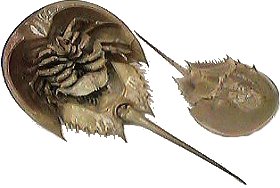
Horseshoe Crabs Limulus polyphemus are extremely common in the rivers and bays of this area. They are actually more closely related to spiders than to the other crustaceans on this page. In fact, technically they are not crustaceans at all. Despite their fierce-looking array of claws and spines, they are completely harmless.
They are also completely inedible - not even the native Indians would eat them except in the direst emergency. They are nonetheless threatened by man since vast numbers are collected commercially for fertilizer, bait, and other uses. Horseshoe Crabs are found from the water's edge down to 75 feet.
More: Atlantic Horseshoe Crab ...
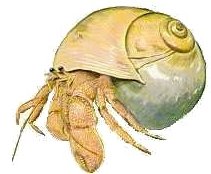
Hermit crabs live inside empty snail shells in shallow water along beaches and in estuaries, small specimens on mudflats and large ones offshore. Some hermit crabs are entirely terrestrial, needing the water only to lay eggs. In the South Pacific, there are types that actually climb trees and very large ones that don't bother with a shell as adults.
The size of the crab determines what kind of shell, and upgrades are required as the crab grows. The Flat-Clawed Hermit Crab Pagurus arcuatus (right) is the largest in our area, and will often use Moon Snails and Whelks, but you will only find the big ones in deeper water. Small ones use Periwinkles and Oyster Drills.
More: Hermit Crabs ...
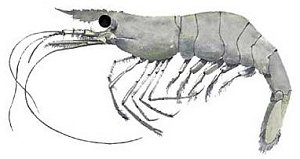
Shrimps live in all habitats from freshwater lakes to salt marshes to the deep ocean. The illustration at right shows a "Grass Shrimp, " however, there are too many types of shrimps to even begin to list them. Shrimps grow from 1" to 8", depending on the species.
Most numerous in our inshore waters are tiny Shore Shrimps or Grass Shrimps, Palaemonetes spp. which are similar to the picture, but only 2" long, and transparent or largely so.
More: Shrimps ...

The Mole Crab or Sand Bug Emerita talpoida lives on ( or rather in ) ocean beaches, burrowing in the surf zone, and at times free swimming. It is totally harmless and grows to 1.5". These odd and somewhat comical little creatures seem to do everything in reverse - they dig backwards, walk backwards, and swim backwards. Fishermen dig them up for bait.
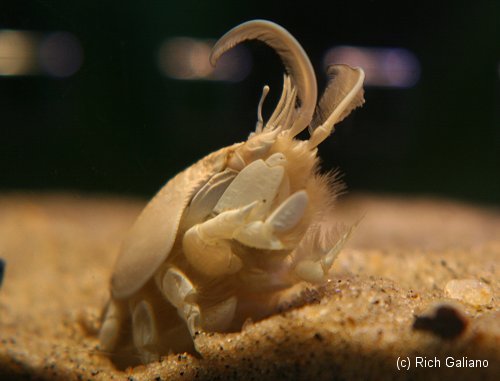
More: Mole Crab ...
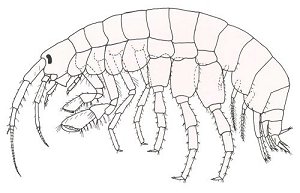
Amphipod crustaceans typically range in size from 2 to 50 mm, although a few may be larger. Amphipods are common in aquatic ecosystems throughout many parts of the world, inhabiting marine, brackish, and freshwater environments. A few species are also terrestrial. Amphipod means "different foot", a reference to the varied legs that are evident in the illustrations, as opposed to isopods.
The order Amphipoda, which contains nearly 7,000 described species, is divided into three suborders: Gammaridea, Caprellidea, and Hyperiidea. Gammaridea, with more than 5500 described species, is not only the largest amphipod suborder but also contains all of the freshwater and subterranean taxa. Approximately 21 superfamily groups, 95 families and more than 1000 genera are recognized within this suborder.
More: Amphipods ...
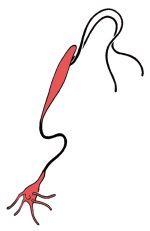

Most copepods are harmless plankters or bottom dwellers. In fact, copepods are the most numerous of all crustaceans in terms of both species and population. However, since they generally range in size from 1/16" to 1/2 ", they are not of much interest to divers.
The Ribbon Louse ( Lernaeenicus spp. far right, 1 inch to 1 foot ) is a fish parasite. I have observed these bizarre creatures only in the aquarium. The head ( at lower left ) is buried in the body of the host, while the worm-like body hangs outside. Only the twin tails betray its true and almost unrecognizable nature - this is a copepod crustacean. And this is not even the extreme of crustacean evolution - some parasitic barnacles live completely inside their host, actually melding with the host's flesh until the two are inseparable, like some kind of science fiction nightmare.
More: Copepods ...
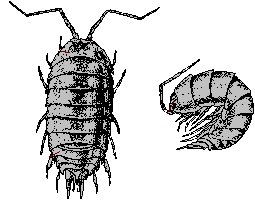
Isopod means "same foot", a reference to the similar legs that are evident in the illustrations, as opposed to amphipods. Isopods are the most widespread of all arthropods, found from the highest mountaintops to the deepest seas. Most isopods are small, although some deep-sea types grow to over a foot in length. Isopods are mainly harmless scavengers, although some are parasites, and larger types can pack a painful bite.
More: Isopods ...

These animals are lumped together here because they all have hard external shells. Crustaceans and Mollusks are not closely related at all. This is more of a restaurant classification than a scientific one.
- American Lobster
- Crabs ...
- Other Crustaceans ...
More: Marine Shellfish ...
